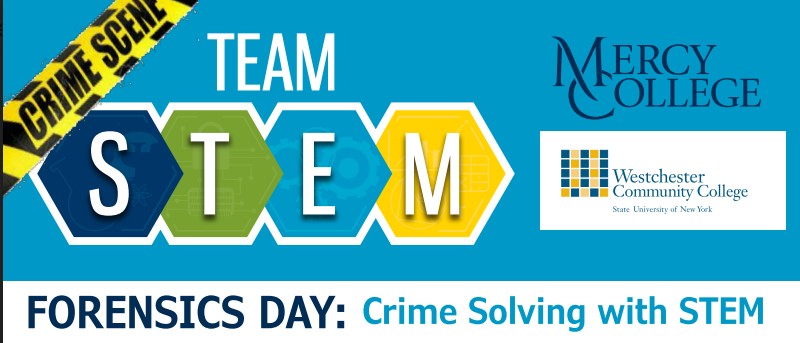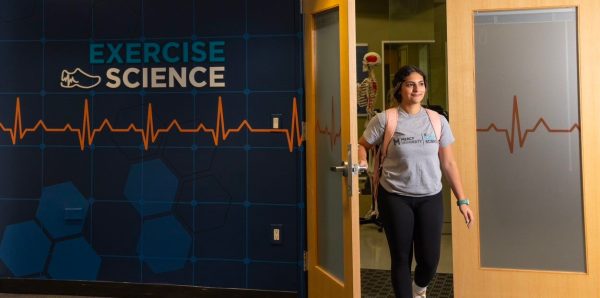Stem Forensics Day Hosts CSI Adventure
Who knew solving a crime with your classmates was a great learning experience?
On Feb. 27, Mercy College hosted STEM Forensics Day, and it was a resounding hit.
Mercy College, Westchester Community College, and local high school students participated in the virtual STEM event held over Zoom. It was a three-hour-long event that used a crime scene as its premise to have STEM students break into groups in their field, the different fields of STEM (Science, Technology, Engineering, and Math), and work collaboratively to solve problems. High school students were invited by the Mercy College Center for STEM Education and were treated to an admissions event after the forensics day.
The day started off by watching the “murder” take place, getting preliminary information and Evidence. The students selected a group to join in Biology, Math, Psychology, Computer Science, or Cybersecurity. Once there, the groups were given specific pieces of evidence to examine using their skill sets and tools in that subject.
By the end of the event, it became clear how each of the specific fields related to each other, and how together, they each contributed meaningful information to solve the crime. The students had a blast working together and learning things that are not usually covered in class along the way.

Dr. Narasim Banavara was one of the professors from Mercy College who helped organize the event with other faculty and staff members. He worked very hard since November to execute the weekend well, and he was quite happy with how it turned out.
“The event was a great success.”
Banavara was involved from the start. “My role was arranging for the faculty to come together, brainstorm ideas for the event, and get this event together. We met every week from November to get the storyline together and the various characters so that we would have a smooth investigation. I arranged for the actors and the cameraman for the event. On Feb 6, I arranged for the filming of the crime scene and the interrogations of the suspects.“
The event was one big group effort behind the scenes and in front as well.
“This event is special because it brings together multiple disciplines (computer science, cybersecurity, mathematics, biology, and psychology) in order to solve a problem. This is true interdisciplinary work. Students see the STEM concepts in action in an almost real-world setting. Students take away multiple concepts and skills and, most importantly, teamwork needed to solve problems.”
Banavara has been involved with STEM for a while now. “In the STEM grant, I am the one of the (two) Activity Directors of the WCC-Mercy STEM Scholars Program. I oversee and arrange the various activities of the program, including Forensics Day, STEM Day, and our flagship activity – the Summer Research Academy, where we encourage undergraduate students to conduct research in computer science, cybersecurity, mathematics, biology, and psychology.”
Another Mercy College Professor, Dr. Renee Haskew-Layton, Biology Program Director and Basic Science Undergraduate Research Coordinator, was heavily involved on Forensics Day as well.
“I am the co-activity director for the WCC-Mercy STEM Pipeline Initiative, this program hosts an annual Forensics Day and STEM Day for Mercy College, Westchester Community College, and High School students. I worked closely with Dr. Banavara (the other co-activity director) and WCC and Mercy STEM faculty to organize the event and develop the storyline for forensics day. I also worked with my colleague Dr. Devdutta Deb to develop a DNA analysis module for STEM day.”
Layton also helped prepare the event along Banavara, she has participated in this event live in person previously and noted some differences. “The virtual format was different because we needed to set up the crime scene ahead of time and pre-record all of the evidence collection.”
She also says she missed having the students in house for the event, as she enjoyed having them do the hands-on parts themselves. Though different, there are benefits.
“One benefit of the virtual format was that it allowed students to spend more time on the analysis of the evidence, since the evidence was collected and recorded ahead of time. This allowed us to spend more time discussing the various aspects of the multi-disciplinary evidence with students and more time analyzing who may have committed the crime (the fictional murder of biotech start-up CEO Madison Olivera).”

Each concentration was very important and equally needed for the crime to have been solved. “The biology group analyzed DNA left at the crime scene, this allowed students to uncover an unknown suspect and pull his past criminal profile. The psychology group interviewed the suspects and analyzed behavioral patterns and motivations for committing the crimes. The math group analyzed blood spatter patterns from the scene of the crime and was able to use mathematical analysis to determine the manner of death of the victim. The cybersecurity group analyzed the internet and social media activity of the suspects and determined their whereabouts during the time the crime was committed.”
Forensics day was a hit amongst students and staff, it was quite different than past years but still kept the core of STEM alive and relevant throughout.
“I hope that students had fun with STEM and were able to get an authentic sense of how STEM fields work together in the real world. I hope that students were inspired by Forensics Day to pursue a degree in STEM and pursue STEM careers.”

Jadeen Mercado is a senior who loves all things entertainment!
She writes a column called Jadeen's Scene
She can be reached at [email protected]...








